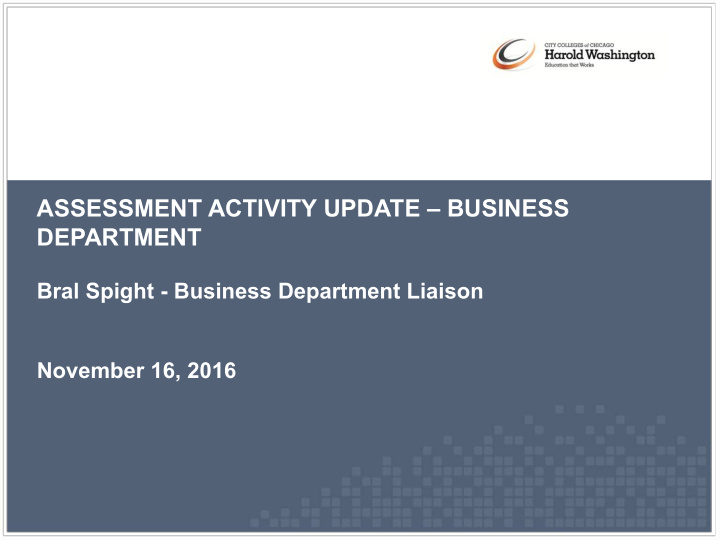



ASSESSMENT ACTIVITY UPDATE – BUSINESS DEPARTMENT Bral Spight - Business Department Liaison November 16, 2016
CONVERSATION HIGHLIGHTS § Why are we doing this? § How did we create the assessment? § What did we end up with? § What did we find out? § Where to next? § Q&A ASSESSMENT COMMITTEE - 1 BUSINESS LIASON REPORT
WHY ARE WE DOING THIS? ASSESSMENTS Activities undertaken by teachers – and by their students in assessing themselves— that provide information to be used as feedback to modify the teaching and learning activities in which they are engaged. Black, P.J. & Wiliam, D. (1998) Inside the Black Box: Raising standards through classroom assessment. King’s College, London. (see http://en.wikipedia.org/wiki/Assessment_for_Learning) ASSESSMENT COMMITTEE - 2 BUSINESS LIASON REPORT
WHY ARE WE DOING THIS? § Our assessment seeks to understand business department student abilities prior to and after entering business department pathways — Prerequisite recommendations — Teacher preparation — Course content refinement — Accreditation ASSESSMENT COMMITTEE - 3 BUSINESS LIASON REPORT
H OW DID WE CREATE THE ASSESSMENT ? § Determined appropriate audience - 6 classes chosen based on pathways and assumed student tenure — Business 111 – Introduction to Business — Business 141 – Business Mathematics — Business 181 – Financial Accounting Early tenure — Business 182 – Managerial Accounting Late Tenure — Business 269 – Principles of Management — Economics 201 – Principles of Economics I § Researched comparable tools – Internet based examples and old end-of-class assessment exams § Alignment check for SLO’s in three “early tenured” classes § Departmental and peer review ASSESSMENT COMMITTEE - 4 BUSINESS LIASON REPORT
W HAT DID WE END UP WITH ? The assessment was designed to maximize participation by students and faculty! § BlackBoard LMS Survey to all sections online and face-to-face § Initial effort achieved enough § 60 minutes (honor system) (14%/ 147) overall responses § 30 questions generally split by “Early to be meaningful Career” course SLOs § Responses by — Accounting (11) population breakdowns — Introduction to Business (10) were also — Business Mathematics (9) enough to be considered § 1 question focused on length of time to meaningful complete ASSESSMENT COMMITTEE - 5 BUSINESS LIASON REPORT
W HAT DID WE FIND OUT ? § 90.4% able to meet the 1 hr limit overall § 4.2% difference between “Early Career” and “Late Career” not significant § Population differences going forward to be probed along with question performance ASSESSMENT COMMITTEE - 6 BUSINESS LIASON REPORT
W HAT DID WE FIND OUT ? P-value 0.054 § Improvement between “Early Career” and “late Career” just a hair above significance at the 0.05 cutoff P-value 0.007 § Difference between “online” and “face to face” is significant at the 0.05 cutoff ASSESSMENT COMMITTEE - 7 BUSINESS LIASON REPORT
W HAT DID WE FIND OUT ? Accounting Intro to Bus Bus. Math. § Low values overall and by population were flagged to determine if there was a question issue or concept issue § Remaining differences by population used as starting points for 30: Leanne had a good first half of the year selling automobiles as detailed remediation below. discussions January - 10 Cars February - 16 Cars March - 10 Cars April - 10 Cars 5: In the preparation May - 12 Cars of a trail balance, June – 12 Cars which of the following is a common error? The average number of car sales Leanne had for the first six months is: ASSESSMENT COMMITTEE - 8 BUSINESS LIASON REPORT
W HAT DID WE FIND OUT ? % Answering Correct By Question Accounting Intro to Bus Bus. Math. 90.0% 80.0% 70.0% 60.0% § Differences between 50.0% 40.0% “Early Career” and 30.0% “Late Career” being 20.0% 10.0% tested for significance 0.0% 1 2 3 4 5 6 7 8 9 10 11 12 13 14 15 16 17 18 19 20 21 22 23 24 25 26 27 28 29 30 § “online” vs. “face to "Early Career" "Late Career" face” also being 30: Leanne had a good first half of the investigated year selling automobiles as detailed below. January - 10 Cars February - 16 Cars March - 10 Cars April - 10 Cars 5: In the preparation May - 12 Cars of a trail balance, June – 12 Cars which of the following is a common error? The average number of car sales Leanne had for the first six months is: ASSESSMENT COMMITTEE - 9 BUSINESS LIASON REPORT
W HERE TO NEXT ? § Continue to refine the tool by probing individual questions for potential gaps in learning § Investigate root causes of any gaps between on-line and face-to-face results § Increase test takers of all types (esp. On-line/ ECON 201) to improve p-values and build up population of test takers § Look at change over time, especially in context of any major course changes § Make and communicate out any recommendations to close observed gaps § Document findings in support of accreditation! ASSESSMENT COMMITTEE - 10 10 BUSINESS LIASON REPORT
Q&A This type of work can be helpful for any department! ASSESSMENT COMMITTEE - 11 11 BUSINESS LIASON REPORT
Recommend
More recommend